 W
WBara is a colloquialism used to refer to a genre of Japanese comic art and media known within Japan as gay manga (ゲイ漫画) or gei komi . The genre focuses on male same-sex love, as created primarily by gay men for a gay male audience. Bara can vary in visual style and plot, but typically features masculine men with varying degrees of muscle, body fat, and body hair, akin to bear or bodybuilding culture. While bara is typically pornographic, the genre has also depicted romantic and autobiographical subject material, as it acknowledges the varied reactions to homosexuality in modern Japan.
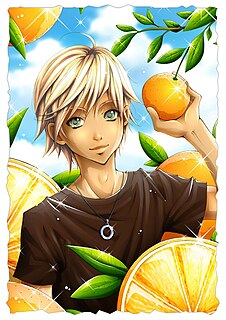 W
WBishōnen is a Japanese term literally meaning "beautiful youth (boy)" and describes an aesthetic that can be found in disparate areas in East Asia: a young man of androgynous beauty. This word originated from the Tang dynasty poem Eight Immortals of the Wine Cup by Du Fu. It has always shown the strongest manifestation in Japanese pop culture, gaining in popularity due to the androgynous glam rock bands of the 1970s, but it has roots in ancient Japanese literature, the homosocial and homoerotic ideals of the medieval Chinese imperial court and intellectuals, and Indian aesthetic concepts carried over from Hinduism, imported with Buddhism to China. Today, bishōnen are very popular among girls and women in Japan. Reasons for this social phenomenon may include the unique male and female social relationships found within the genre. Some have theorized that bishōnen provide a non-traditional outlet for gender relations. Moreover, it breaks down stereotypes surrounding feminine male characters. These are often depicted with very strong martial arts abilities, sports talent, high intelligence, dandy fashion, or comedic flair, traits that are usually assigned to the hero/protagonist.
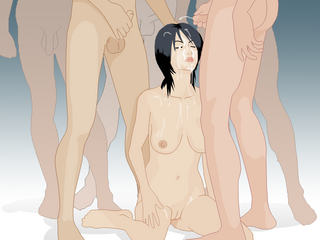 W
WBukkake is a sex act in which one participant is ejaculated on by two or more other participants. It is often portrayed in pornographic films.
 W
WBurusera (ブルセラ) is a paraphilia, specifically a sexualized attraction to the underwear or school uniforms of girls or young women. It is a word of Japanese origin, coined by combining burumā (ブルマー), meaning bloomers, as in the bottoms of gym suits, and sērā-fuku (セーラー服), meaning sailor suit, the traditional Japanese school uniforms for schoolgirls; notably kogal. Burusera shops sell girls' used school uniforms, panties and other fetish items.
 W
WIn a sexual context, groping is touching another person in an unwelcome sexual way. The term generally has a negative connotation in many societies, and the activity may be considered sexual assault or otherwise unacceptable. Touching a consenting person's body during sexual activity, massage, or medical examination is not usually considered groping, though the term is sometimes used to include clumsy, selfish, or inappropriate sexual touching. Areas of the body most frequently groped include the buttocks, breasts, vulva and thighs on a woman, and the penis, testicles and buttocks on a man. Gropers might use their hands, but pressing any part of their body against another person can be considered groping.
 W
WCock and ball torture (CBT), penis torture or dick torture is a sexual activity involving application of pain or constriction to the penis or testicles. This may involve directly painful activities, such as genital piercing, wax play, genital spanking, squeezing, ball-busting, genital flogging, urethral play, tickle torture, erotic electrostimulation, kneeing or kicking. The recipient of such activities may receive direct physical pleasure via masochism, or emotional pleasure through erotic humiliation, or knowledge that the play is pleasing to a sadistic dominant. Many of these practices carry significant health risks.
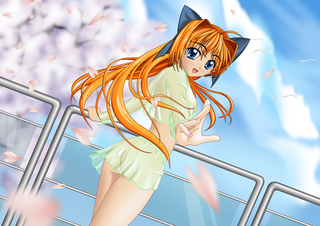 W
WEcchi is an often used slang term in the Japanese language for playfully sexual actions. As an adjective, it is used with the meaning of "sexy", "dirty" or "naughty"; as a verb, ecchi suru means “to have sex” or, as a noun, to describe someone of lascivious behavior. It is perhaps softer than the Japanese word ero, and does not imply perversion in the way hentai does.
 W
WFutanari is the Japanese word for hermaphroditism, which is also used in a broader sense for androgyny.
 W
WGokkun (ごっくん) is a Japanese term for sexual activity in which a person, usually a woman, consumes the semen of one or more men, often from some kind of container. "Gokkun" can also refer to the sexual act of swallowing semen after performing fellatio or participating in a bukkake. The word "gokkun" is onomatopoetic, and translates roughly as the English word "gulp", the sound made by swallowing.
 W
WHentai is anime and manga pornography. A loanword from Japanese, the original term does not describe a genre of media, but rather an abnormal sexual desire or act, as an abbreviation of hentai seiyoku . In addition to anime and manga, hentai works exist in a variety of media, including artwork and video games.
 W
WKinbaku (緊縛) means "tight binding," while Kinbaku-bi (緊縛美) literally means "the beauty of tight binding." Kinbaku is a Japanese style of bondage or BDSM which involves tying a person up using simple yet visually intricate patterns, usually with several pieces of thin rope (often jute, hemp or linen and generally around 6 mm in diameter, but sometimes as small as 4 mm, and between 7–8 m long. In Japanese, this natural-fibre rope is known as asanawa ; the Japanese vocabulary does not make a distinction between hemp and jute. The allusion is to the use of hemp rope for restraining prisoners, as a symbol of power, in the same way that stocks or manacles are used in a Western BDSM context. The word shibari came into common use in the West at some point in the 1990s to describe the bondage art Kinbaku. Shibari is a Japanese word that broadly means "binding" or "tying" in most contexts, but is used in BDSM to refer to this style of decorative bondage.
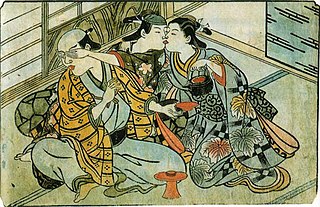 W
W'Kagema' (陰間) is a historical Japanese term for young male sex workers. Kagema were often passed off as apprentice kabuki actors and catered to a mixed male and female clientele. For male clients, the preferred service was anal sex, with the client taking the penetrative role; homosexual fellatio is almost unmentioned in Tokugawa-era documents.
 W
WLolicon (ロリコン), also romanized as lolikon or rorikon, is Japanese discourse or media focusing on an attraction to young girls. The term, a portmanteau of the phrase "Lolita complex", describes an attraction to young girls, an individual with such an attraction, or the lolicon genre of media including manga and anime, where childlike female characters are often depicted in an "erotic-cute" manner (ero-kawaii). Within the context of otaku subculture, the term lolicon usually describes an attraction to fictional characters in media such as manga and anime, and not an attraction to realistic representations of girls or real girls as such.
 W
WNawashi (縄師), is a word which in SM circles means "rope artist". Nawashi are those who have some recognized proficiency in the historic erotic art of kinbaku (緊縛) or kinbaku-bi.
 W
WNyotaimori , often referred to as "body sushi", is the Japanese practice of serving sashimi or sushi from the naked body of a woman. Nantaimori (男体盛り) is the male equivalent.
 W
WPanchira (パンチラ) is a Japanese word referring to a brief glimpse of a woman's underwear. The term carries risqué connotations similar to the word 'upskirt' in English.
 W
WShotacon , abbreviated from Shōtarō complex , is a Japanese slang describing an attraction to young boys, more specifically in the way of moe. It refers to a genre of manga and anime wherein prepubescent or pubescent male characters are depicted in a suggestive or erotic manner, whether in the obvious role of object of attraction, or the less apparent role of "subject". In some stories, the young male character is paired with a male, usually in a homoerotic manner, which is most common in yaoi/Boys' Love (BL) works meant for female readers, but some of these works are male-oriented, such as Boku no Pico. In others, he is paired with a female, which the general community would call "straight shota" or oneshota (おねショタ), a blend of onē-san and shota. A cutoff of "about 15" has been suggested as the dividing line between shotacon and BL. It can also apply to post-pubescent characters with neotenic features that would make them appear to be younger than they are. The phrase is a reference to the young male character Shōtarō (正太郎) from Tetsujin 28-go. The equivalent term for attraction to young girls is lolicon.
 W
WRecords of men who have sex with men in Japan date back to ancient times. Western scholars have identified these as evidence of homosexuality in Japan. Though these relations had existed in Japan for millennia, they became most apparent to scholars during the Tokugawa period. Historical practices identified by scholars as homosexual include shudō (衆道), wakashudō (若衆道) and nanshoku (男色).
 W
WShunga (春画) is a type of Japanese erotic art typically executed as a kind of ukiyo-e, often in woodblock print format. While rare, there are also extant erotic painted handscrolls which predate ukiyo-e. Translated literally, the Japanese word shunga means picture of spring; "spring" is a common euphemism for sex.
 W
WCock and ball torture (CBT), penis torture or dick torture is a sexual activity involving application of pain or constriction to the penis or testicles. This may involve directly painful activities, such as genital piercing, wax play, genital spanking, squeezing, ball-busting, genital flogging, urethral play, tickle torture, erotic electrostimulation, kneeing or kicking. The recipient of such activities may receive direct physical pleasure via masochism, or emotional pleasure through erotic humiliation, or knowledge that the play is pleasing to a sadistic dominant. Many of these practices carry significant health risks.
 W
WTelekura , an abbreviation for "telephone clubs" , are telephone-based dating services originating in Japan.
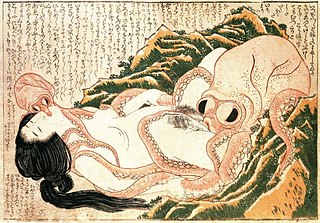 W
WTentacle erotica or tentacle rape is a type of pornography most commonly found in Japan which integrates traditional pornography with elements of bestiality and a fantasy, horror, or science-fiction theme. It is found in some horror or hentai titles, with tentacled creatures having sexual intercourse, predominantly with females. Tentacle erotica can be consensual but frequently contains elements of rape.
 W
WWakashū is a historical Japanese term indicating an adolescent boy, used particularly during the Edo period, pre-1868. Wakashu status was indicated by haircut.
 W
WYaoi, also known by the wasei-eigo construction boys' love and its abbreviation BL , is a genre of fictional media originating in Japan that features homoerotic relationships between male characters. Though it is typically created by women for women and is distinct from homoerotic media marketed to gay men, it attracts a male audience and can be produced by male creators. It spans a wide range of media, including manga, anime, drama CDs, novels, video games, television series, films, and fan works. "Boys' love" and "BL" are the generic terms for this kind of media in Japan and much of Asia; though the terms are used by some fans and commentators in the West, yaoi remains more generally prevalent in English.
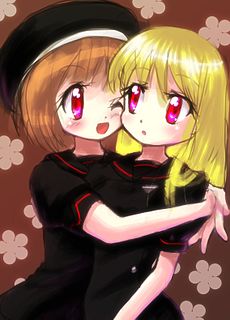 W
WYuri , also known by the wasei-eigo construction girls' love , is a genre of Japanese media focusing on intimate relationships between female characters. While lesbianism is a commonly associated theme, the genre is inclusive of works depicting emotional and spiritual relationships between women that are not necessarily romantic or sexual in nature. Yuri is most commonly associated with anime and manga, though the term has also been used to describe video games, light novels, and literature.